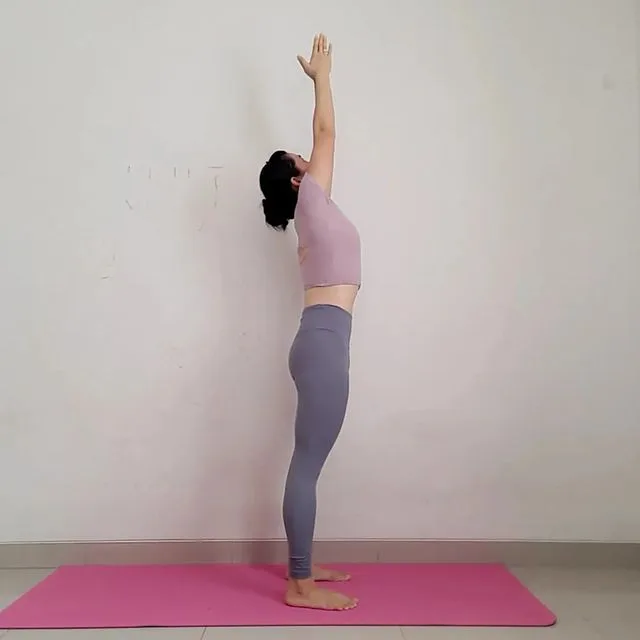Urdhva Hastasana, also known as Upward Salute, stretches the chest, shoulders and abdomen, while strengthening the arms and shoulders. It is a basic yoga pose, often performed as a warm-up or as part of a sun salutation sequence.
Information
| Known as: | Urdhva Hastasana, Upward Salute, Raised Hands Pose |
| Sanskrit name: | ऊर्ध्व हस्तासन |
| IAST: | Urdhva Hastāsana |
| Pronunciation: | OORD-vah hahs-TAH-suh-nuh |
| Level: | Beginner |
| Type: | Standing pose |
| Total time: | 30 to 60 seconds plus |
| Drishti: | Forward; Upward towards the hands |
| Focus: | Chest, shoulders, spine, arms, wrists, legs |
| Chakra: | Anahata (heart) chakra, Vishuddha (throat) chakra |
| Indications: | Arms, wrists, legs, shoulders, chest, belly, balance, stability, digestive system, circulation, relaxation, stress, anxiety |
| Counterposes: | Uttanasana (Standing Forward Bend Pose), Adho Mukha Svanasana (Downward-Facing Dog Pose), Balasana (Child’s Pose), Tadasana (Mountain Pose), Vrksasana (Tree Pose) |
| Preparatory poses: | Tadasana (Mountain Pose), Uttanasana (Standing Forward Bend Pose), Adho Mukha Svanasana (Downward-Facing Dog Pose), Ardha Uttanasana (Half Standing Forward Bend Pose), Gomukhasana (Cow Face Pose) Arms |
| Follow-up poses: | Uttanasana (Standing Forward Bend Pose), Trikonasana (Triangle Pose), Virabhadrasana II (Warrior II Pose), Adho Mukha Svanasana (Downward-Facing Dog Pose), Balasana (Child’s Pose) |
| Contraindications: | Shoulder injuries or shoulder pain, neck injuries, high blood pressure, pregnant women, vertigo, lower back pain or spinal issues |
Meaning
Urdhva Hastasana is a Sanskrit name, composed of two words – Urdhva + Hasta + Asana:
- “Urdhva” = “upward” or “elevated”
- “Hasta” = “hands”
- “Asana” = “pose” or “posture”
Therefore, Urdhva Hastasana can be translated as “Upward Salute Pose” or “Raised Hands Pose”.
The pose is called Urdhva Hastasana because the arms are lifted up towards the sky, creating an upward or elevated position, while the palms face each other in a salutation gesture. The pose is often used as a starting point or transitional pose in many yoga sequences, and is considered a foundational pose for standing poses and Sun Salutations.
In addition to the physical benefits of the pose, Urdhva Hastasana is also said to activate the Anahata (heart) chakra and promote feelings of openness, joy, and compassion.
Benefits of Upward Salute
Urdhva Hastasana is a simple yet powerful yoga pose that can be practiced on its own or as part of a larger yoga practice. Its physical and mental benefits make it a great pose for beginners and experienced yogis alike. The physical and mental benefits are listed below:
- Physical Benefits:
- Stretches the chest, shoulders, and belly.
- Strengthens the arms and shoulders.
- Improves posture and opens the chest, allowing for better breathing.
- Stimulates the nervous system, promoting mental alertness and clarity.
- Stretches the sides of the body, including the intercostal muscles, promoting deeper breathing.
- Help relieve tension in the neck, shoulders, and upper back.
- Improve digestion and relieve constipation by massaging the abdominal organs.
- Mental Benefits:
- Promotes feelings of openness, joy, and compassion.
- Help relieve anxiety and stress by promoting a sense of calm and relaxation.
- Improve focus and concentration, helping to clear the mind.
- Promote a sense of inner strength and confidence.
- Help cultivate a sense of gratitude and appreciation for the body and its abilities.
Step-by-step instructions to Urdhva Hastasana
- Begin standing in Tadasana (Mountain Pose) with your feet hip-distance apart, reaching down through all four corners of your feet.
- Bring your hands to your hips and lengthen your spine, keeping your shoulders relaxed.
- As you inhale, raise your arms overhead, bringing your palms together in prayer position or keeping them shoulder-width apart, facing each other.
- As you raise your arms, keep your shoulders relaxed and draw your shoulder blades down your back.
- Gently lengthen through your fingertips and keep your gaze forward or up toward your hands.
- If it feels comfortable, you can gently lift your heels off the ground and balance on the balls of your feet.
- Hold the pose for 30–60 seconds, or as long as feels comfortable.
- To come out of the pose, as you exhale, release your arms by your sides and come back to Tadasana.
Precautions and contraindications
While Urdhva Hastasana is generally a safe pose for most people, there are some precautions and contraindications to keep in mind. They include:
- People with shoulder injuries or shoulder pain should avoid lifting their arms overhead or modify the pose with the help of a yoga teacher.
- People with neck injuries or high blood pressure should avoid looking up in the pose and can keep their gaze forward or down.
- Pregnant women should avoid practicing this yoga pose after the first trimester and should modify the pose with the help of a yoga teacher.
- People with vertigo or balance issues should avoid practicing the pose without the help of a yoga teacher.
- People with lower back pain or spinal issues should avoid compressing the lower back and can modify the pose by keeping their hands on their hips or thighs.
If you experience any pain or discomfort during the pose, come out of the pose slowly and gently. If you have any concerns or medical conditions, it is best to consult with a doctor or a qualified yoga teacher before practicing Urdhva Hastasana.















